LONG TIME NO WRITE IN MY BLOG!!
Happy, happy. Why i'm say that? Because 2pm will be back to indonesia
And thats really Fun for HOTTEST.
Can't Wait ! Can't Wait ! :D
LONG TIME NO WRITE IN MY BLOG!!
Happy, happy. Why i'm say that? Because 2pm will be back to indonesia
And thats really Fun for HOTTEST.
Can't Wait ! Can't Wait ! :D
 |
 |
 |
 |
 |
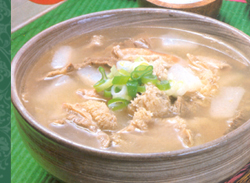 |
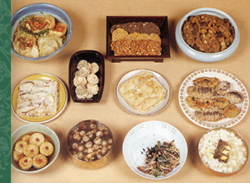 |
 |
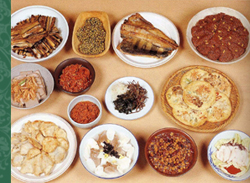 |
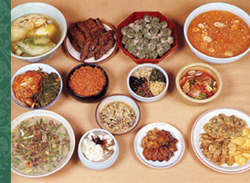 |
 |
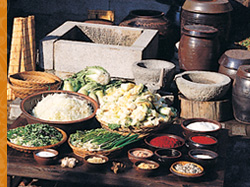 |
| Ingredients used in kimchi (cabbage, spices, etc.) |
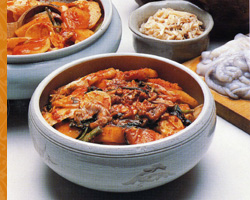 |
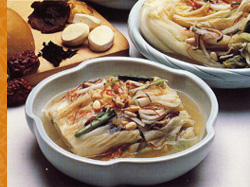 |
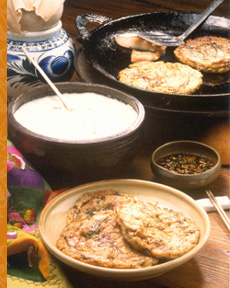 |
| Kimchijeon (pan-fried kimchi) |
| Foods enjoyed on festive days and in particular seasons
Foods for special occasions include festive foods that were enjoyed on holidays in particular months and seasonal dishes prepared with foods produced in the current season. Throughout the year, Korean ancestors prepared different foods for each holiday and enjoyed fresh foods grown in the spring, summer, fall and winter. Days with odd-numbered dates falling in the same-numbered month were considered festive days. These include Danil (Jan. 1), Dansam (Mar. 3), Dano (May 5), Chilseok (July 7) and Junggu (Sept. 9) in the lunar calendar. Today, New Year's Day, Daeboreum (Jan. 15th according to the lunar calendar), Hansik ("cold food" day, the 105th day after the winter solstice), Dano, Sambok (the hottest period of summer), Chuseok (Thanksgiving Day), and Dongji (winter solstice) are observed as meaningful customs, and we renew their meaning each year. On New Year's Day, all Koreans start the day with tteokguk (sliced rice cake soup), and wish for health, happiness and good luck. On Daeboreum, we eat ogokbap (boiled rice mixed with five grains), dried vegetables and nuts and ask for a successful year filled with vigor and good health. On Chuseok, we thank our ancestors for the joy of the harvest and fruit-bearing. We share our pleasure with others by preparing and sharing various dishes cooked with freshly harvested produce. On Dongji, we cook red bean porridge to ward off bad luck. Similar seasonal foods were enjoyed by both royals and commoners and throughout different regions. Festive days in Korea are mostly seasonal customs related to monthly farming events. The seasonal customs of the Joseon Dynasty are described in detail in books such as Dongguk Sesigi, Kyeongdo Japji and Yeolyang Sesigi. |
| [Festive foods and seasonal foods] | |||||||||||||||||||||||||||||||||||||||||||
|
| ▣ Spring Foods |
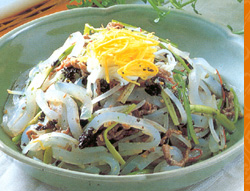 Tangpyeongchae, enjoyed in late spring, is a mix of green bean jelly, pork, dropwort and dried laver seasoned with soy sauce and vinegar. Tangpyeong
means maintaining one's balance. King Yeongjo allegedly created
Tangpyeongchae out of a strong desire for balance among parties. Tangpyeongchae, enjoyed in late spring, is a mix of green bean jelly, pork, dropwort and dried laver seasoned with soy sauce and vinegar. Tangpyeong
means maintaining one's balance. King Yeongjo allegedly created
Tangpyeongchae out of a strong desire for balance among parties.
Suran, soft-boiled eggs, tastes very good when dipped lightly in soy sauce seasoned with vinegar. Jogiguk is a soup made with short-necked clams and croakers. Hadon means blowfish. A bowl of soup cooked with blowfish and dropwort and seasoned with oil and soy sauce tastes excellent when it is prepared before the peach flowers wither. Domijjim (steamed sea bream) was prepared at the time when the fish were at their most flavorful. It was also called seunggiaktang, which means the dish was so delicious that it was more enjoyable than a party with the gisaengs (Korea's Geishas). Seoyeojeungsik consists of steamed hemp dipped in honey. It is served on a plate with fresh fruit. Various types of rice cakes are prepared. In the book Dongguk Sesigi, rice cake dough is rolled into small balls, stuffed with red bean paste, dyed in five different colors and threaded onto a string. This is called whanbyeong, which means beaded rice cakes. In addition, rice cakes tinted blue, white or pink were shaped into half-moons. Five small ones of them or two or three big ones are sometimes linked together, which is called sanbyeong. This is similar to what we call gaepitteok today. A larger five-colored rice cake is called majebyeong. Sirutteok (layers of steamed rice cake) made with glutinous rice and topped with jujube is another seasonal food eaten in spring. |
| ▣ Summer Foods |
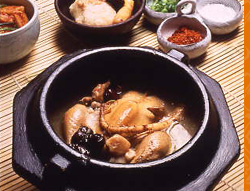 Gijutteok is a rice cake enjoyed in summer. It is prepared by mixing rice flour with liquor and then steaming the fermented dough. Gijutteok is a rice cake enjoyed in summer. It is prepared by mixing rice flour with liquor and then steaming the fermented dough.
In summer, hwajeon (pan-fried dough with petal toppings) is prepared by placing yellow rose petals on top of round, flat biscuits of glutinous rice dough. Eochae is a cooked fish dish. White fish meat is shredded into small pieces, sprinkled with starch and boiled lightly in hot water. When served, it is decorated with cucumber, manna lichens and paper-thin strips of fried egg. Eomandu is a dumpling prepared with fish instead of flour dough. A beef stuffing is wrapped with thin slices of white fish meat. It is steamed and served with soy sauce seasoned with vinegar. Dropwort rolls are prepared by boiling dropwort or soft scallions in hot water and forming each strip into a roll. Served with seasoned hot pepper paste as a sauce, it makes a perfect side dish for liquors. Flour noodles are added to sesame soup and adorned with shredded squash and small strips of chicken. Seaweed is boiled in chicken soup and then mixed with flour noodles. Sliced squash is coated with flour and whipped eggs and pan-fried. Heads of croakers are cooked to make jijimi (a stew). Yellow melons are regarded as the best fruit to eat to cool off in the summer heat. In the royal court, rice dumplings left over from New Year's Day are soaked in water to make tteokguk. Winter foods are enjoyed in summer to chase away the heat. |
| ▣ Fall Foods |
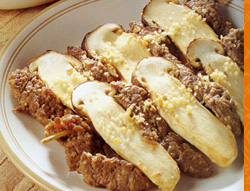 In fall, the harvest is at its peak and the new crop of the year is rich, as are the hearts of the people. Chuseok is also called Gabae or Hangawi. In rural areas, lunar New Year's Day and Chuseok
are considered as the most important holidays. As it is the season when
five different grains are fully grown, fruits are ripe and vegetables
are abundant, new grain liquors are brewed from the fresh crops. Fresh
fruits are picked and offerings for ancestors are prepared to be used in
a rite. This is called the Chuseok rite. Festive foods for Hangawi include songpyeon (stuffed rice cake), torantang (taro soup), various seasoned vegetables and galbijjim (rib stew). In fall, the harvest is at its peak and the new crop of the year is rich, as are the hearts of the people. Chuseok is also called Gabae or Hangawi. In rural areas, lunar New Year's Day and Chuseok
are considered as the most important holidays. As it is the season when
five different grains are fully grown, fruits are ripe and vegetables
are abundant, new grain liquors are brewed from the fresh crops. Fresh
fruits are picked and offerings for ancestors are prepared to be used in
a rite. This is called the Chuseok rite. Festive foods for Hangawi include songpyeon (stuffed rice cake), torantang (taro soup), various seasoned vegetables and galbijjim (rib stew).
Rice cakes such as singwabyeong, mulhobaktteok, musirutteok, bam danja (chestnut balls) and jujube injeolmi (sticky rice cake), which are adorned with freshly harvested fruits such as chestnut, jujube and persimmon before being steamed, are also special dishes. Songi sanjeok, prepared by skewering songi (pine mushrooms) and beef, is another delicacy enjoyed in fall. |
| ▣ Winter Foods |
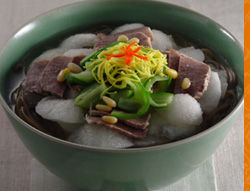 Dongji
(the winter solstice) is the longest night and shortest day of the
year. Meaning "a day that ushers in the following year," Dongji was also
called ase (sub-year) or "little New Year's Day." Dongji
(the winter solstice) is the longest night and shortest day of the
year. Meaning "a day that ushers in the following year," Dongji was also
called ase (sub-year) or "little New Year's Day."
At the homes of commoners, porridge was cooked using red beans. Glutinous rice powder was rolled into small balls to be added to the porridge, which is served with honey. Offering the first harvest of the season to one's ancestors and spreading red bean porridge on doors were popular customs that were believed to keep evil spirits away. These days, Koreans eat a bowl of red bean porridge to ward off evil spirits. Festive foods for Dongji included red bean porridge, jeonyak (a mixture of herbs, honey, sugar and pepper), sikhye (a sweet dessert made with rice), sujeonggwa (a fruit punch) and dongchimi (water kimchi). Jeonyak was offered to the king on Dongji, and then distributed to his followers. To prepare jeonyak, gelatin is dissolved, herbs (dried ginger, dried cloves, etc.) are ground into a fine powder and jujubes are boiled and passed through a sieve. These are mixed with honey and boiled for a long time to make them harden into a jelly. It is actually a kind of herbed jelly. It is known to protect our bodies from the cold throughout the winter. Nanrohoe is a seasonal food enjoyed in urban areas. When the weather becomes cold, people gather around a large stove with a stew pot on top. They stir-fry marinated meats and add broth to the pot and let it boil. Sinseollo originally meant a pot and stove in one. In this pot, various meats and vegetables were neatly arranged and a broth added for simmering. It is also called yeolgujatang or guja, which means "pleasing to the mouth." Naengmyeon (cold noodles) is one of favorite seasonal choices in winter. In the late Joseon Dynasty, King Gojong was especially fond of noodles and he enjoyed naengmyeon as a nighttime snack. Since King Gojong didn't like spicy foods, the only garnishes on the noodles were slices of boiled meat, pear and pine nuts. Instead of beef stock, the noodles were added to dongchimi (water kimchi) with a lots of pear, which gave the noodles a very sweet and refreshing flavor. |
| When cooking, we use various ingredients to create the distinctive flavor of each dish while preserving the individual taste of each food used. We call these ingredients seasonings. | |
Basic seasonings used in Korean cooking include salt, soy sauce, hot pepper paste, soybean paste, vinegar and sugar. As for aromatic seasonings, ginger, mustard, pepper, hot pepper, sesame oil, perilla oil, sesame, green onion, garlic and Chinese pepper are used. A Korean dish is usually prepared using at least five or six different condiments, thereby offering a unique flavor not found in other countries. |
|
Different types of soy sauce are used in cooking depending on the dish. For soups, stews and vegetables, light-colored mild soy sauce is used. A dense soy sauce is favored for boiling, drying and pickling. Soy sauce is not only used in cooking; it is also mixed with vinegar or other seasonings and served as a sauce. When it is served with a pan-fried dish, dumplings or cold dumplings, vinegar is added to the soy sauce. When making a seasoned soy sauce for use in noodle dishes or grain-based jellies, hot pepper powder, minced green onion and garlic are usually added to enhance the flavor. |
|
|
|
Korean cooking does not focus solely on taste, overlooking appearance. Korean food, which is decorated in five naturally occurring colors in consideration of attractiveness and health, is adorned with colorful garnishes in the noble spirit of suggesting that the food has been specially prepared just for you. It also seems to covey the subtle elegance appreciated by Koreans. |
|
Egg jidan is shredded to garnish vegetables or japchae (glutinous noodles mixed with stir-fried vegetables) or cut in rectangles or diamonds to be used as toppings in soup, stew or casseroles. Jidan is cut into different shapes to match the dish in which it is being served. Then meatballs are made by finely mincing lean beef, then adding seasonings and shaping the meat into small balls. They are coated lightly with flour and whipped eggs and cooked evenly on a greased pan. Meatballs are used as utgi in noodle dishes, casseroles or sinseollo (a fancy hot-pot boiled at the table). Nuts, including pine nuts, ginkgo nuts and walnuts, are also often used as garnishes. |
| Korea has much in common with China and Japan in terms of dining style due to
frequent cultural and historical exchanges. But over time, Korea has developed its own unique cuisines.
Korea was once a primarily agricultural nation, and boiled rice has become Koreans’ stable food. Stable food and side dishes are clearly distinguished in Korean table settings. A traditional Korean meal consists of a bowl of rice and side dishes. Koreans use a wide arrange of ingredients such as meat, fish, vegetables and seafood with unique seasonings. As there are many ways to cook these ingredients, Koreans have developed diverse kinds of cuisines. |
|
Bap, or boiled rice, is the staple of Korean cuisine. Barley, millet, beans, and red beans are sometimes mixed with rice for special taste and nutritional value. Vegetables, seafood, and kimchi are also added to rice when cooking for a better taste. One of the most famous rice dishes is bibimbap, boiled rice mixed with seasoned vegetables and meat. Juk, or porridge, is grains boiled over time with a lot of water. Many varieties of juk exist, such as juk made of pine nuts, abalones, sesame, walnuts, and mung beans. Mieum is a thin porridge and Eungi is a thin starch porridge. Naengmyeon (buckwheat noodles in a cold broth), manduguk (dumpling soup), tteokguk (rice cake soup) are cuisines enjoyed in everyday life and on special occasions. These dished are also often enjoyed for lunch. |
|
A Korean table is never completed without soups such as guk, tang and jjigae which always accompany bowls of rice. They are made of a variety of ingredients such as beef, seafood, and vegetables, with seasonings such as salt, soy bean sauce, bean paste, and seafood fermented in salt. Soups that most frequently appear on Koreans’ tables include seaweed soup, bean paste soup, seolleongtang (beef and bone soup), yukgaejang (spicy beef soup). Jjigae, gamjeong, and jochi are similar to guk, but they are thicker in texture and stronger in taste. They are seasoned with bean paste, red pepper paste, and shrimp fermented in salt. Gamjeong refers to jjigae seasoned with red pepper paste. Jochi is the term for jjigae served during a royal meal. Casserole is a soup with seasoned meat and vegetables. It is boiled and cooked on the spot and shared by many people. |
|
Namul, vegetable or wild-greens dishes, is one of the most basic side dishes in the Korean diet. While namul refers to both raw and cooked vegetables and wild-greens, it usually means cooked ones these days. Almost all kinds of seasonal vegetables and wild-greens are used for namul dishes. Koreans often skewer and dry the ingredients to use them when they’re out of season. There are different ways to cook namul according to the type of its ingredients. Vegetables with green leafs are parboiled and seasoned with combinations of salt, soy sauce, sesame seeds, sesame oil and garlic. Wild greens such as Chinese bellflowers are boiled and stir-fried with seasonings. Fresh seasonal vegetables are not boiled, but tossed in a sweet and sour seasoning. |
|
Gui, or grilled dishes, first appeared in the Korean diet when Koreans began to use fire for cooking. Neobiani is a type of grilled dish served in royal cuisine. It is thinly sliced beef marinated in a bulgogi sauce (soy sauce, sugar, garlic, green onions, and sesame oil), and then grilled at the table over charcoal. Sanjeok is a grilled brochette made of seasoned meat, vegetables and mushrooms. There are many kinds of sanjeok according to their ingredients, such as sanjeok made of beef and vegetables, mushrooms, green onions and fish. Sanjeok brings beauty to the table as it is made by putting ingredients of many colors onto skewers. Jeon is a pan-fried dish. It is also called as Jeonyueo or Jeonyuhwa. These dishes include thinly sliced meats, fish, and vegetables that are coated in flour, dipped in egg and pan-fried. Some common pan-fried dishes include pan-fried summer squash, pan-fried fish, and pan-fried meat. Jijim is a small pancake made of flour batter pan-fried with various ingredients. Some popular pancakes include mung bean pancake, green onion pancake, and layers of thin wheat pancake. |
|
Pickled and Dried Foods for Long Storage Jangajji is vegetables pickled in soy sauce, red pepper paste or soybean paste. They are stored for a long time and used as a side dish in winter times when vegetables are hard to get. Jeotgal and sikhae are also a type of stored foods. They include seafood fermented in salt. Another type of stored food includes twigak (deep-fried seaweed or leaves and stems of various vegetables), bugak(deep-fried vegetables coated with starch), and po (beef or fish jerky). Yukpo, one of the most popular types of jerky, is thin slices of beef marinated in soy sauce, then dried in the shade. It is often served as a dried snack with alcohol or prepared for a wedding ceremony. Kimchi is Korea’s most representative fermented food and the most basic side dish in the Korean diet. As it is an indispensable part of any Korean meal, some people say they cannot have a meal without Kimchi. There are many different kinds of Kimchi depending on region and its ingredients. Kimchi comes in various colors and tastes according to its ingredients, and types of jeotgal, or fermented seafood, used to make it. There is also a water kimchi with its refreshing and tangy juice. |
|
Hoe (raw fish or meat), Ssam (vegetable leaf wraps), Muk (jelly) – Cuisines Unique to Korea Hoe is raw meat, fish, or vegetables served with dipping sauces such as red chili pepper paste with vinegar and sugar, soy sauce with vinegar and sugar, mustard, and salt with sesame oil. Sukhoe is similar to hoe, but it uses parboiled ingredients. Some of the popular ingredients for sukhoe include parboiled parsley, small green onions, and fatsia shoots. Ssam, vegetable leaf wraps, is an unique eating style of the Korean diet which is loved by many Koreans. Ssam is spoonfuls of rice wrapped in wide leafs such as lettuce, Chinese cabbage, sesame leafs, fresh seaweed and dried laver with soybean paste. Also unique to Korean food is jokpyeon, pressed ox feet, and muk, firm jelly made of acorn, mung bean, or buckwheat starch. |
|
Tteok (traditional rice cake), and Hangwa (traditional sweets and cookies) for Festive and Seasonal Occasions and Ancestral Memorial Services Koreans always prepare for tteok and hangwa for festive occasions and a variety of special occasions. They are usually enjoyed as desserts these days. There are wide varieties of tteok based on how to make it. Sirutteok is rice power mixed with other ingredients and steamed in a siru, an earthenware steamer. Jeolpyeon and injeolmi is made by steaming glutinous rice and pounding it to make a firm and sticky dough. Bukkumi and hwajeon is kneaded glutinous rice dough shaped into small circles and pan-fried. Jeungpyeon is a steamed rice cake made with white rice flour and rice wine. It is also called as Sultteok, or rice wine cake. Yaksik, also called as yakban and yakbap, is steamed sticky rice made with chestnuts, jujubes (Korean dates), honey, pine nuts and cinnamon. Hangwa is traditional Korean sweets and cookies. It is rice or wheat flour dough mixed with honey, yeot (sticky rice sugar), and sugar and then deep-fried. It is also made by simmering fruits and plants’ roots in honey syrup until they are glazed. It is also called as jogwa, which means cookies made of natural produce by adding artificial flavor. There is a wide variety of hangwa, such as yakgwa (deep-fried honey cookies), sanja (deep-fried sweet rice cookies), ganjeong (deep-fried sweet rice puffs), yyeotgangjeong (malt toffees), dasik (traditional pressed sweets), and jeonggwa (candied fruits and roots). |
| ▶ | Geographic position - Between 33˚ and 43˚ north latitude, and 124˚ and 131˚ east longitude (including North Korea) |
| ▶ | Highest mountains in S. Korea - Hallasan on Jeju Island, 1,950 meters (6,400 ft); Jirisan, 1,915 meters (6,283 ft); and Seoraksan, 1,708 meters (5,604 ft) |
| ▶ | Rivers - Nakdonggang, 522 km (324 miles); Hangang, 494 km (307 miles); Geumgang, 396 km (246 miles) |
| ▶ | Economic status (2010) – GNI USD 986.2 billion; GNI per capita: USD 20,759 |